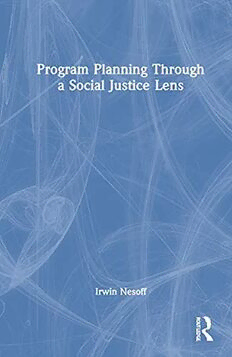
Human Service Program Planning Through a Social Justice Lens PDF
Preview Human Service Program Planning Through a Social Justice Lens
Human Service Program Planning Through a Social Justice Lens Human Service Program Planning Through a Social Justice Lens provides a foundation in social justice to students while developing practical skills and knowledge about the steps and tasks involved in planning social programs. Through the “parallel process” of contextualizing social issues while teaching the process of program planning, students will develop a per- spective on the need for social justice planning and its impact on mar- ginalized communities and populations. The textbook explores current concepts and approaches to understanding social issues and involving impacted communities and individuals. These include: Intersectionality, Appreciative Inquiry, Participatory Planning and Visioning, which serve to challenge preconceptions while coupling these with the step-by-step approach to planning using the Logic Model. Utilizing meaningful examples to demonstrate how social justice plan- ning can be implemented, Human Service Program Planning Through a Social Justice Lens is appropriate for students of social work as well as practitioners in human services, public administration and public health. Irwin Nesoff served as a non-profit executive for fifteen years before join- ing the social work faculty at Kean University in New Jersey. He later joined the faculty at Wheelock College in Boston where he taught social work before becoming the founding chairperson of the Department of Leadership and Policy. He holds a Doctorate in Social Welfare awarded by the City University of New York Graduate Center. Human Service Program Planning Through a Social Justice Lens Irwin Nesoff Cover image: © Irwin Nesoff First published 2022 by Routledge 605 Third Avenue, New York, NY 10158 and by Routledge 4 Park Square, Milton Park, Abingdon, Oxon, OX14 4RN Routledge is an imprint of the Taylor & Francis Group, an informa business © 2022 Taylor & Francis The right of Irwin Nesoff to be identified as author of this work has been asserted in accordance with sections 77 and 78 of the Copyright, Designs and Patents Act 1988. All rights reserved. No part of this book may be reprinted or reproduced or utilised in any form or by any electronic, mechanical, or other means, now known or hereafter invented, including photocopying and recording, or in any information storage or retrieval system, without permission in writing from the publishers. Trademark notice: Product or corporate names may be trademarks or registered trademarks, and are used only for identification and explanation without intent to infringe. Library of Congress Cataloging-in-Publication Data A catalog record for this title has been requested ISBN: 9780367709754 (hbk) ISBN: 9780367709761 (pbk) ISBN: 9781003148777 (ebk) DOI: 10.4324/9781003148777 Typeset in Times New Roman by codeMantra Support Material is available for this title at www.routledge.com/9780367709761 This book is dedicated to Paula Nesoff, my life partner, muse and inspiration. Forever and… and The young activists of the Movement for Black Lives and the Sunrise Movement. You give me hope for a future built on social justice. Contents List of Figures ix Introduction xi 1 Social Justice Thinking 1 2 Working with the Community to Define the Issue 41 3 Determining Need 67 4 From Understanding the Issue to Developing the Impact 100 5 The Process of Program Planning: Theory of Change and Logic Models 120 6 Lasting Change Requires a Detailed Strategy 144 7 Developing the Program Logic Model 164 8 The Program Narrative 182 9 Program Evaluation 199 Index 215 Figures 1.1 Houselessness viewed through systems thinking 8 1.2 Intersectionality 13 1.3 Moving from dependence to interdependence 16 1.4 Paradigm shift 19 1.5 Wealth disparity in the U.S. 20 1.6 White vs. Black wealth 21 1.7 Maintaining the status quo 23 1.8 Structural poverty 25 1.9 School suspensions and expulsions, 2016 27 1.10 Social capital 31 2.1 Do not use “lack of” 43 2.2 Food insecurity contributing factors 44 2.3 Cultural competence and cultural humility compared 48 2.4 Getting from Point A to Point B 56 2.5 Flow of information 58 2.6 Maslow’s hierarchy 59 3.1 Program planning flow chart 70 3.2 Summer learning loss and the achievement gap 71 3.3 Defining the issue 72 3.4 Asset thinking vs. deficit thinking 77 3.5 Demographic data for the community (U.S. Census Bureau) 79 3.6 Community asset map 82 3.7 Relational organizing 93 3.8 Force field analysis 94 4.1 Role of the intervention hypothesis 103 4.2 The impact of assumptions 112 4.3 How the issue statement leads to impact 114 4.4 Theory of change components 117 5.1 Three approaches to rational planning 125 5.2 Structured decision making 128 5.3 Evidence-informed planning 135 5.4 Theory of change phases 137 5.5 Logic model template 139
